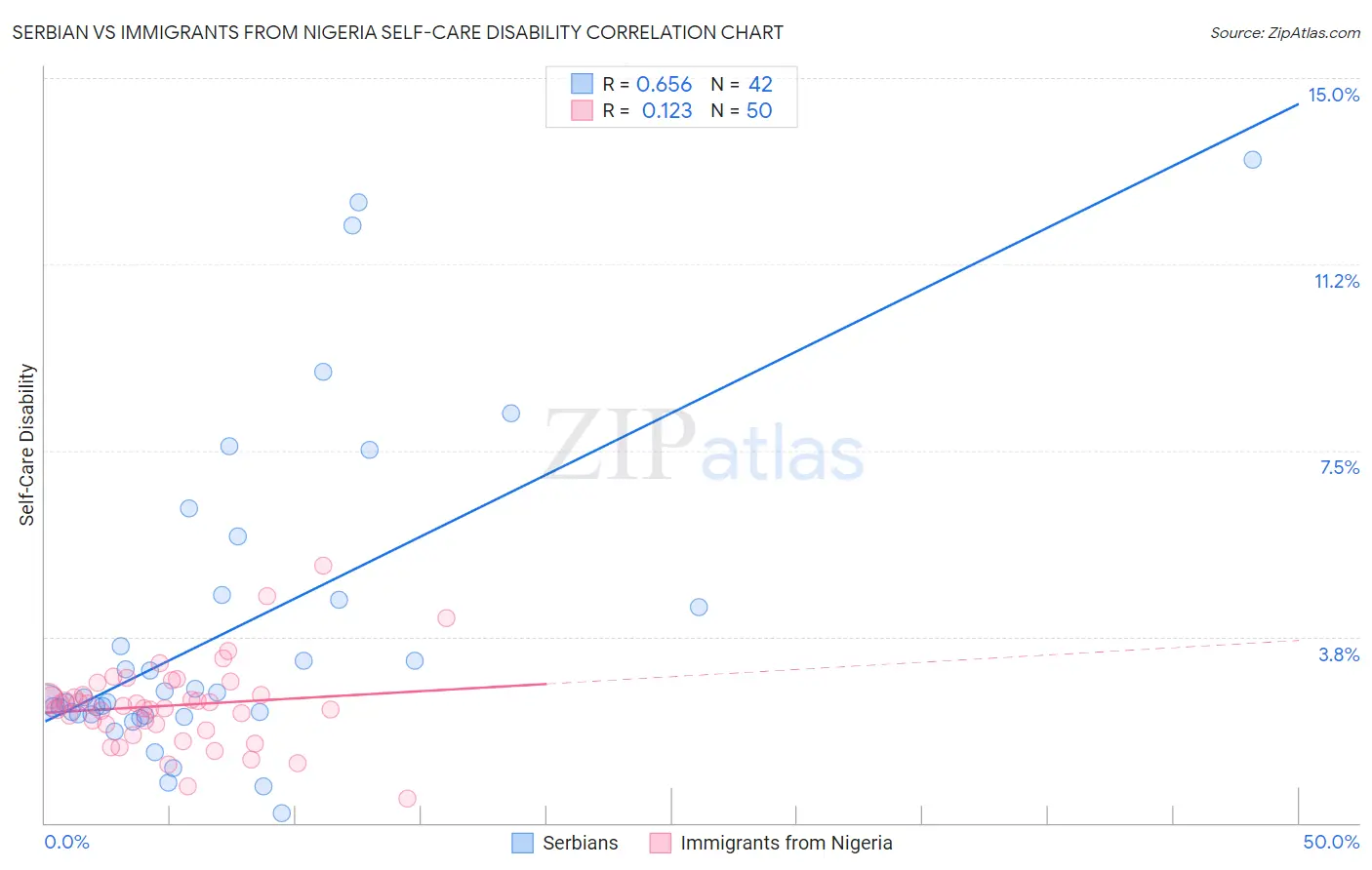Serbian vs Immigrants from Nigeria Self-Care Disability
COMPARE
Serbian
Immigrants from Nigeria
Self-Care Disability
Self-Care Disability Comparison
Serbians
Immigrants from Nigeria
2.4%
SELF-CARE DISABILITY
93.6/ 100
METRIC RATING
111th/ 347
METRIC RANK
2.4%
SELF-CARE DISABILITY
90.3/ 100
METRIC RATING
123rd/ 347
METRIC RANK
Serbian vs Immigrants from Nigeria Self-Care Disability Correlation Chart
The statistical analysis conducted on geographies consisting of 267,466,690 people shows a significant positive correlation between the proportion of Serbians and percentage of population with self-care disability in the United States with a correlation coefficient (R) of 0.656 and weighted average of 2.4%. Similarly, the statistical analysis conducted on geographies consisting of 283,219,403 people shows a poor positive correlation between the proportion of Immigrants from Nigeria and percentage of population with self-care disability in the United States with a correlation coefficient (R) of 0.123 and weighted average of 2.4%, a difference of 0.56%.

Self-Care Disability Correlation Summary
| Measurement | Serbian | Immigrants from Nigeria |
| Minimum | 0.20% | 0.50% |
| Maximum | 13.4% | 5.2% |
| Range | 13.2% | 4.7% |
| Mean | 3.9% | 2.4% |
| Median | 2.5% | 2.4% |
| Interquartile 25% (IQ1) | 2.2% | 2.0% |
| Interquartile 75% (IQ3) | 4.5% | 2.6% |
| Interquartile Range (IQR) | 2.3% | 0.59% |
| Standard Deviation (Sample) | 3.2% | 0.85% |
| Standard Deviation (Population) | 3.1% | 0.84% |
Demographics Similar to Serbians and Immigrants from Nigeria by Self-Care Disability
In terms of self-care disability, the demographic groups most similar to Serbians are Immigrants from Africa (2.4%, a difference of 0.020%), Scandinavian (2.4%, a difference of 0.020%), South American (2.4%, a difference of 0.090%), Immigrants from North Macedonia (2.4%, a difference of 0.090%), and Immigrants from Hong Kong (2.4%, a difference of 0.090%). Similarly, the demographic groups most similar to Immigrants from Nigeria are Immigrants from North America (2.4%, a difference of 0.010%), Immigrants from Morocco (2.4%, a difference of 0.010%), Hmong (2.4%, a difference of 0.050%), Belgian (2.4%, a difference of 0.080%), and Colombian (2.4%, a difference of 0.080%).
| Demographics | Rating | Rank | Self-Care Disability |
| British | 94.3 /100 | #107 | Exceptional 2.4% |
| Greeks | 94.1 /100 | #108 | Exceptional 2.4% |
| Slovenes | 94.1 /100 | #109 | Exceptional 2.4% |
| Immigrants | Africa | 93.7 /100 | #110 | Exceptional 2.4% |
| Serbians | 93.6 /100 | #111 | Exceptional 2.4% |
| Scandinavians | 93.5 /100 | #112 | Exceptional 2.4% |
| South Americans | 93.2 /100 | #113 | Exceptional 2.4% |
| Immigrants | North Macedonia | 93.1 /100 | #114 | Exceptional 2.4% |
| Immigrants | Hong Kong | 93.1 /100 | #115 | Exceptional 2.4% |
| Northern Europeans | 92.9 /100 | #116 | Exceptional 2.4% |
| Taiwanese | 92.5 /100 | #117 | Exceptional 2.4% |
| Immigrants | Canada | 92.0 /100 | #118 | Exceptional 2.4% |
| Immigrants | Sierra Leone | 91.8 /100 | #119 | Exceptional 2.4% |
| Uruguayans | 91.5 /100 | #120 | Exceptional 2.4% |
| Peruvians | 91.3 /100 | #121 | Exceptional 2.4% |
| Belgians | 90.9 /100 | #122 | Exceptional 2.4% |
| Immigrants | Nigeria | 90.3 /100 | #123 | Exceptional 2.4% |
| Immigrants | North America | 90.2 /100 | #124 | Exceptional 2.4% |
| Immigrants | Morocco | 90.2 /100 | #124 | Exceptional 2.4% |
| Hmong | 89.9 /100 | #126 | Excellent 2.4% |
| Colombians | 89.7 /100 | #127 | Excellent 2.4% |